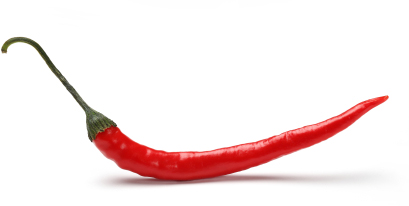The first time I ever had a chilli was when I was 18 years old and working as a door-to-door salesman in Italy. In those days I could pretty much only afford one meal a day (which speaks volumes for my sales technique) but decided to chance the Pizza Atomica in a restaurant in Arezzo. After about two bites my mouth was hotter than Tahiti and tears were welling in my eyes – and not just because I knew I was going to go hungry again that night.
I vowed never to make the same mistake again, but in the 20-year interim I have in fact become a chilli addict. I am forever being told that I eat too much of it, the general consensus being that as I am vegetarian I need to spice up my boring meals with something hot and fiery. As a consequence, apparently I can’t even taste my food. Needless to say, this is utter nonsense.
I’m not saying that I’m not liberal with the odd drizzle of chilli oil here and there, or a daub of sauce or oil from time to time to give my meal a cheeky kick, but any self-respecting chilli connoisseur will tell you that, generally speaking and when used in the right quantities, far from disguising the taste of your food, chilli enhances it.
Of course too many of our red and green friends and the taste buds will be blitzed, but gradually, like most things in life, the more accustomed to them you become, the greater your tolerance. So the seasoned chilli-fiend can still enjoy the flavour of most dishes while enjoying that chilli hit.
That is the beauty of chilli. The reason it is so addictive is because as soon as you eat it, the brain produces endorphin, a natural painkiller that gives a natural rush – a feeling of mild euphoria. And, no, I don’t get out much these days.
I’m not saying that chilli goes with everything – those chilli-flavoured chocolate bars that are all the rage on the Continent, for example, are just plain wrong. They ruin the sweet luxuriant aftertaste that is the whole point of eating chocolate in the first place.
An old friend of mine and fruit and vegetable vendor, Bruno Fulgoni, was forever on at me that chilli was no good for the guts and perhaps he was just trying to get me to use his downstairs toilet, but as it turns out he was wrong, because chillies are one of the most nutritious foods you can eat. Here’s ten reasons why.
1. Chillies contain seven times more vitamin C than an orange.
2. Chillies are a source of vitamin A, B and E and include minerals such as molybdenum, manganese, folate, potassium, thiamin, and copper.
3. Chillies help keep you slim because they burn calories more easily. Try the Dorset Naga chilli – the hottest in the world – and you’ll lose weight alright. You’ll be in the can before you can say ‘D-arse-t’.
4. The beta-carotenoids in the Vitamin A and C in chillies contain powerful antioxidants, which destroy free radical bodies, which when untracked can damage nerve and blood vessels, build up cholesterol, or lead to other diseases such as cataract, osteoarthritis, rheumatoid arthritis and diabetes.
5. The Capsaicin in chillies has been found in laboratory tests to inhibit the growth of prostate cancer cells. In studies carried out on animals it was found that tumours got smaller when they were given doses of chilli. It appears that capsaicin causes cell death by attacking mitochondria – the respiratory centres of cells.
6. It has also been noted that vitamin C, beta-carotene and folic acid found in chilli – particularly the red pepper, which contains cartonoid lycopene, reduces the risk of colon cancer.
7. As well as helping remove waste product from our bodies chillies increase the supply of nutrients to the tissues.
8. Chillies act as an anti-biotic bringing fresh white blood cells and leukocytes to the site of infection, where they fight virusus.
9. The vitamin B6 and folic acid in chillies help fight against heart attacks and strokes. The vitamin B reduces high homocysteine level which has been shown to cause damage to blood vessels.
10. The Capsaicin in chillies also dilates the airway of the lungs which reduces asthma and wheezing and gives relief from nasal congestion by increasing the metabolism.
There are all myriad chillies out there on the market varying in type, flavour and heat, which is officially measured by Scoville heat units (SHU). The SHU scale normally ranges from 0-300,000. At the milder end of there are the Anaheim, poblanos (or anchos) and every day bell peppers, in the middle lie the jalapenos, cherry and Hungarian wax peppers and tipping the scale marked ‘hotter than Rosie Huntington Whiteley on a hen weekend’ are the fruity habaneros, piqu’ns (or bird peppers), Thai chillies and the aforementioned Dorset Naga – a chilli named after its county of provenance – is so hot that its growers, Joy and Michael Michaud, had to wear gloves to handle them. When measured the heat of the Dorset Naga was quite literally off the scale, measuring some 900,000 SHU. Stick that on your pizza and eat it.

